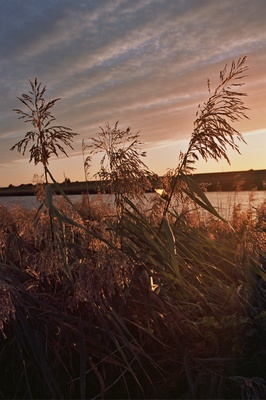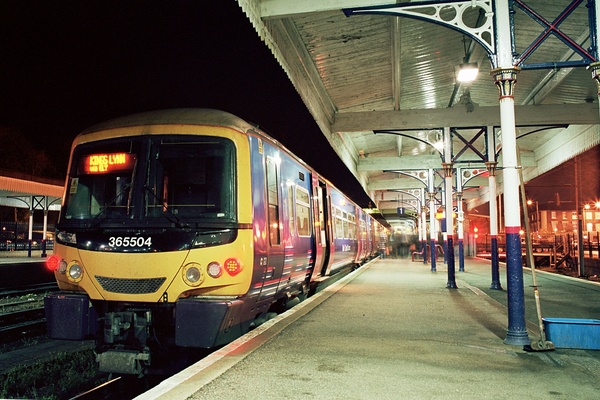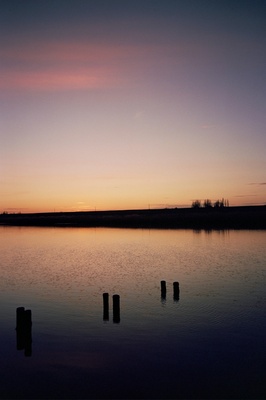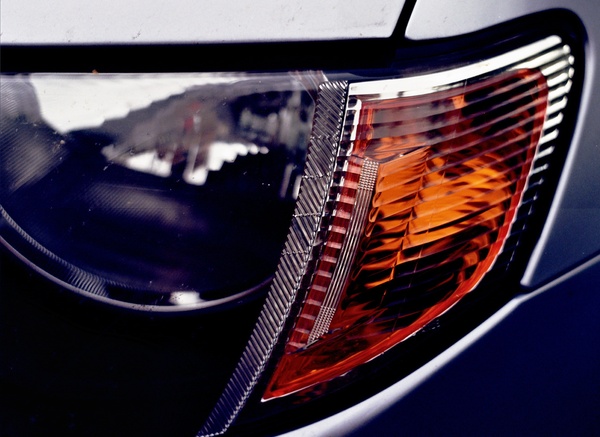
from Shutter, by Lewis Collard

You can happily ignore the whole of this article and take this to the bank: Kodak Ektar 100 is what keeps me shooting film. Ektar is the greatest colour negative film for still and landscape photography ever made. It looks incredible and it can be developed just about anywhere in the world very cheaply (unlike slide and old-school black-and-white films).
Kodak Ektar is an extremely-fine-grain, very saturated colour negative film that obsoletes all colour negative films and most slide films for landscape and still photography. It has a lot of shadow detail (far too much for my tastes), far-beyond-rated dynamic range, and very natural-looking contrast. It has pretty poor reciprocity characteristics, and it is also not a good film for photographs of white people.
The rest of this article is trivia for most purposes. Go get some and be amazed.

Reeds.
Canon A-1 and
Canon FD 28mm f/2.8, with Kodak Ektar 100.
Caveat: The colour you get out of Ektar, like any negative film, is only as good as your scanner, and of the person scanning it. The guy working my local lab is a professional wedding photographer that I can trust to get things right, so I'm basing my experience off that. You may or may not get better results scanning and printing yourself.
With that said, Ektar is wonderful for everything except photographs of white people. Ektar pumps all colours way the hell up, far more than any colour negative film I have ever seen. This is great for the still and landscape photography I focus on. The downside is this:

Aggh!! I've gone pink! Trust me, my skin is not that colour, not even with it being a horribly cold day as it was when I took that snapshot. That isn't a fluke:

They're both pink too! I promise, pink doesn't run in our genes.
Again, I don't think it's a fluke; almost all of the great-looking shots of white people I've seen done on Ektar 100 are extremely desaturated (Ektar is a very colourful film). One of the few that were not was taken in shadow, where the light is naturally bluer (making white people look not quite as red). Non-Caucasians look just fine on Ektar, from what I've seen.
With that said, very careful manual scanning and post-processing will allow you to fix this problem. My buddy Viktor Fejes shoots white people with Kodak Ektar all the time, and his people photographs look incredible. Only worry about this if you're lazy like me and don't scan anything yourself.

365504
at King's Lynn. Canon A-1 and
Canon FD 28mm f/2.8, 15 seconds at f/9.5.
Wonderful. If you want super-clean low-ISO shots, shoot any digital camera; film is film and it has grain. I like the look of film grain; unlike digital noise, it's primary luminance noise (small variations in brightness), not the chroma noise (think coloured speckles) that you get from digital at high ISOs.
Because of the nature of film grain, there's no comparison to make to the boring digital high-ISO test shots you'll get on "photography" websites, but let's play that game anyway. Here's a 100% crop of a 3000x2000 scan from the top left hand corner of the unsharpened version of the above train picture:

Pleasant, but even this is unfair to Ektar; of course if you shoot black emptiness on film you're going to see grain. For real photography with textures, grain is just visible enough to be pleasant at any sensible enlargement.
Remember, that's on 35mm film. Shoot medium-format 120 film in a Kiev 88 and the grain will be about half as visible at any given enlargement. Shoot it in 4x5 and you'll need to blow it up to billboard size and stare at it from 6 feet away before you notice any grain.
Natural. Actually, I like pulling a stop or so of contrast out of my Ektar scans, when I'm not feeling lazy. I've seen people saying that this has a look like digital in the shadows, in that it picks up a lot of detail where film usually does not. They're right to some degree, hence the minimal post-processing I do to push dark shadows back to where they should be.

Stumps.
Canon T90 and Canon FD 28mm f/2.8 shooting
Kodak Ektar 100.
Originally only 35mm, you can now get it in 120, 4x5, and 8x10, yee-haw! Wait around and I'm sure it's going to come out in APS just for the serious pros out there.
It was strange, watching the media proclaim the final death of film as Kodachrome was retired at the end of 2010. Meanwhile, the manufacturer of Kodachrome came out with a multiple-award-winning colour negative film that everyone loved so much that they couldn't make enough of it in enough formats.
Kodak says that it requires no exposure compensation for exposures up to 1 second, and to "make tests under your conditions" for anything longer. That's nice, but not always possible.
Astrophotographers report cyan and green colour shifts for the very long exposures they use. I'm not an astrophotographer, but here's some actual exposures I've used for urban night photography. Remember, because it's colour negative film, I tend towards overexposure; these may not necessarily be the most accurate exposure times, but they work fine for me.
Kodak rates Ektar 100 as being tolerant of two stops of overexposure and one stop of underexposure. Pffffft:

Fence. Kiev 88
and probably the Mir-26B 45mm f/3.5 shooting Kodak Ektar 100.
The above shot was at least two stops underexposed. I'd just swapped from a back loaded with ASA 400 black-and-white film and I forgot to adjust the ASA dial on the TTL metering prism and so I shot this at ASA 400! Oops, two stops underexposed, even if you believe the meter!
What's more fun than that is that I was using it at the ASA 400 setting; my Kiev's TTL prism is horrendously inaccurate. Under those lighting conditions, ASA 400 is probably closer to ASA 800, which would make this closer to three stops underexposed. There's a little bit of a blue shift there, and it's picked up some (pleasant) amount of contrast, but it hasn't ruined the shot, by any means. I wouldn't lose sleep if I accidentally shot a roll of this at a couple of stops underexposed.
Don't take my word for it; here is a guy who accidentally shot a roll at ASA 1600 (four stops underexposed), developed it at ASA 100, and was still able to recover a reasonable amount of detail in post-processing. Crazy!
I don't pay any attention to the figure for overexposure latitude; negative films are always far more tolerant of this than their box-rated values are. Don't hesitate to shoot it a stop or two over rather than bracketing.
It's a matter of taste:

Headlight.
Praktica MTL3 and Pentacon 50mm f/1.8
shooting Kodak Ektar 100, pushed to ASA 400.
Push-processed (rather than push-scanned, as with the exposure latitude example) Ektar picks up a ton of contrast. Reds super-saturate, yellows might desaturate a little, and you get an extreme blue colour shift. Another example:

G.
Praktica MTL3 and Pentacon
50mm f/1.8 shooting Kodak Ektar 100, pushed to ASA 400.
I did say extreme: the area around the G is actually green.
Boo! This is boring! But if you care, here's Kodak's MTF curve:

If you don't know what this means, congratulations! That means you're a photographer, not a tech trivia geek; go out and shoot while the boring people are staring at graphs. Be happy, because Ektar will happily out-resolve most lenses that sensible people are likely to own, hooray.
I don't scan anything myself. All of these were scanned automatically by my favourite lab on an Agfa D-lab three-shot CCD scanner, which works great. I'm lazy, sorry. Those with plenty of time on their hands might get slightly better results from a dedicated film scanner and a proper film profile for Ektar, but I'm still too lazy for that; if I wanted to spend hours playing with shots on my computer I'd be shooting digital for my serious work. And if I'm honest, most of the home-scanned results I've seen look pretty crappy and washed-out for my tastes, anyway.

Not added this to my gallery yet, since
I'm not sure I like it, but what do you think? Kodak Ektar 100,
Canon FD 28mm f/2.8, probably 20 seconds at f/8. This looks almost
monochromatic because my lab's scanner tried to balance out the
orange colour shift from the sodium lights, which had the effect
of taking almost all the colour from the shot. Here's a fun
exercise for you: go and look at a green car and a blue car
under orange-coloured sodium lighting. Oh my God, they look
almost the same! This is because they give out light within
an extremely narrow range of the spectrum (about 590nm).
Let this be clear: Film is a very personal thing. Far more so than cameras; I can live with using cameras I'm not very comfortable with using (hello, Kiev) and I'd get exactly the same results from any film camera as I did from the ones here.
Every film looks different. Which is "best" is a matter for individual taste, so what you see below is what looks right for me for the things I shoot with Kodak Ektar. Don't feel that I have questioned your choices or that I think you should change your mind, because if it works for you, that's the most important thing.
With that said:
Ektar was the name of another line of C-41 films made from 1989 to 1997. This is a totally different film. It was also the name for a line of lenses made from the late 1930s onwards. You can read all about Kodak lenses over at the Camera Wiki.
Try some. Everyone who does loves it.
What's great about film is that you can take your dad's old film SLR, load it with this film, and you have the state of the art in your hands! The Canon AE-1 or Nikon FE that you stole from his cupboard immediately benefits from the last 30 years of innovation put into film emulsions.
Fuck yeah, film! :D